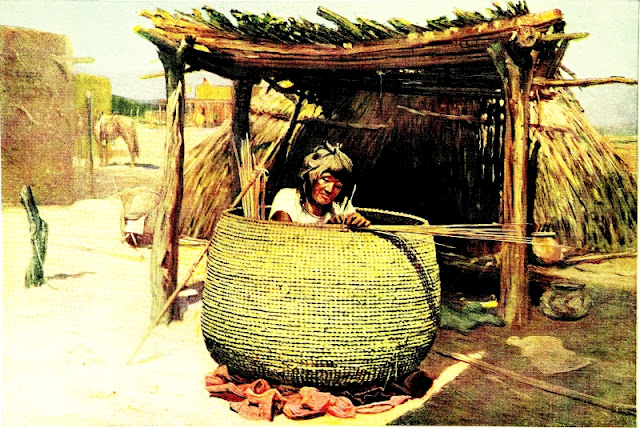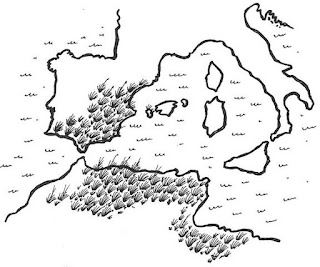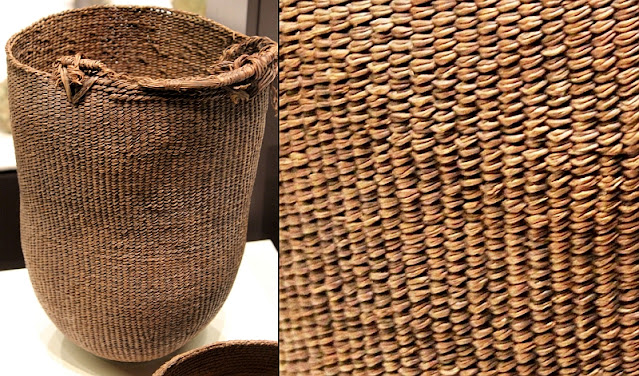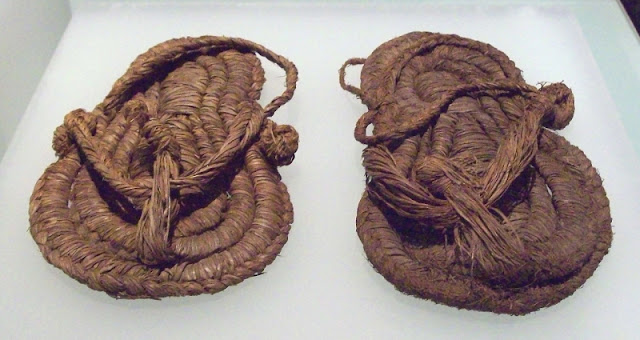Basket Weaving
and Woven-Fiber Technology
in the Pre-Pottery Neolithic (PPN)
By Rick Doble
is to be used as a store for grains and vegetables."
This storage basket is very similar to an early Neolithic basket that was just found.
American Indians: first families of the Southwest by Huckel.
THE NEOLITHIC TIME PERIOD: It is generally agreed that the time period of the Neolithic in the Levant went from ca. 10,000 BCE to ca. 4000 BCE when the first cities began to emerge in Mesopotamia. The first part of the Neolithic era, known as Pre-Pottery Neolithic A & B (PPN), ran from ca. 10,000 to ca. 6,500 BCE. This was followed by the Pottery Neolithic time period which ran from ca. 6,500 - ca, 4,000 BCE. In other words the PPN eras lasted about 3500 years and its technology proceeded the later Pottery Neolithic which lasted about 2500 years.NOTE: These dates can only be roughly assigned and will change as discoveries are made. At the moment the above applies to the areas around the Tigris and Euphrates Rivers and the Persian Gulf.
ABOUT THE NEOLITHIC TIME PERIODThe Neolithic is not a fixed time period. It is a time after the Upper Paleolithic (the late Old Stone Age) and before the emergence of civilization when hunter-gatherers settled into a permanent sedentary life of villages and agriculture. For example, in Europe the Neolithic ended much later than in Mesopotamia and Egypt. The first civilizations in Mesopotamia emerged about 6000 years ago while the first European civilizations began less than 4000 years ago.NOTE ABOUT THE MESOLITHIC: There is a time period between the Upper Paleolithic and the Neolithic called the Mesolithic which was a transitory period when many hunter-gatherers became semi-nomadic, for example. In this blog-article I mainly am concerned with the Neolithic time before the emergence of civilization.
Persistent Controversies About The Neolithic Revolution"The domestication of plants and animals is a necessary but not a sufficient condition for the transition from foraging to an economy fully-based on agriculture to occur. Indeed, domestication can be seen as an innovation but many other innovations are required for the whole human population to be fed from agropastoralism activities."These additional innovations are respectively related to the production of food resources, their processing, storage and consumption. Even if we consider agriculture in its first stage, specific tools and techniques are required, for instance, a digging stick to sow grains, an irrigation system, even if it is very basic or a sickle to harvest cereals. Once they have been harvested, domestic cereals require human activity, in the form of threshing and winnowing, to separate and disperse seeds. Once the seeds were obtained, they had to be stored in order to reduce the seasonal food risks. This requires some storage systems."Even though the innovations listed above seem us to be very basic they were all necessary for a complete transition to agriculture."(Svizzero, "Persistent Controversies About The Neolithic Revolution")
PACK ANIMAL, any domesticated animal that is used to carry freight, goods, or supplies. The ass or donkey is the oldest-known pack animal, having been in use possibly as early as 3500 BCE
WHAT WAS USED BEFORE PACK ANIMALS? BURDEN BASKETS?
Although the following is only an educated guess, I believe it is worth considering as it provides a logical way that harvesting and processing grain, for example, would have been done before pack animals.
I suggest that early Neolithic people employed 'burden baskets'. These are often huge baskets, carried on the back, that are capable of carrying a substantial amount of harvested plants. These baskets are still in use by hunter-gatherers today and were widely used by nomadic Native American Indians and other tribes. They were so important many Indian tribes had a unique design and also a unique name for these baskets as they had a special status. And they are still in use today in virtually every region of the world. Of course, like all baskets, we do not have direct evidence as these baskets from long ago would have decayed and left no indication of their existence. But their wide cross-cultural use, use by contemporary hunter-gatherers, and continued recent use on farms suggest that they could have been made in the Neolithic time period and would have helped accomplish the work these societies needed to bring in the harvest.
 Contemporary pygmy hunter-gatherers use burden baskets for a variety of purposes.
Contemporary pygmy hunter-gatherers use burden baskets for a variety of purposes.<https://commons.wikimedia.org/wiki/File:Pygm%C3%A9es_(RDC).jpg>
 LEFT: "Haymaking - man collects grass in a pannier"
LEFT: "Haymaking - man collects grass in a pannier"RIGHT: Harvest in Argenteuil (France) at the beginning of the 20th century.
<https://commons.wikimedia.org/wiki/File:046_Fienagione_-_uomo_raccoglie_l%27erba_in_una_gerla.jpg>
<https://commons.wikimedia.org/wiki/File:Vendange_argenteuil_95.png>
 LEFT: Pima Carrying Frame
LEFT: Pima Carrying Frame(Aboriginal American Basketry, 1904, Fig. 100, p. 294)
RIGHT: "Pima Indian woman...carrying firewood in her Kathak"
(University of Southern California, 1904, Pima Indian woman)
 "Silva, 3 years old, goes to the field with her mother in 1954," Slovenia.
"Silva, 3 years old, goes to the field with her mother in 1954," Slovenia.<https://commons.wikimedia.org/wiki/File:Silva,_3_leta,_Planina,_gre_s_koškom_z_materjo_na_njivo_1954.jpg>
Burden baskets are just one example of woven-fiber technology that could have been used in the Neolithic era. And even when pack animals were common, they carried baskets, such as these esparto donkey panniers pictured here.
As I pointed out earlier, for more than half of the Neolithic era, there was no pottery, yet these agricultural societies clearly needed a wide variety of containers and related items for harvesting, winnowing, milling, sifting, and storing plus household items for cooking.
I argue that many woven-fiber items were invented, created, and used for agriculture. But as I wrote in the article before this one, much of this technology had been handed down from Paleolithic societies. Here are some examples of grain processing baskets that Native American Indians used around 1900 when these photos were taken. As I have pointed out in my previous article, many Native American Indians lived a way of life that was roughly equivalent to the Upper Paleolithic in Europe so studying their technology may be helpful.
<https://commons.wikimedia.org/wiki/File:Paiute_indian_woman_grinding_acorns_for_flour,_Lemoore,_Kings_County,_ca.1900_(CHS-922).jpg>
RIGHT: Yokut woman shifting meal.
<https://archive.org/details/aboriginalameric00maso/page/n579/mode/2up>
 "Gathering Seeds--Coast Pomo," 1911, Edward_S._Curtis_Collection.
"Gathering Seeds--Coast Pomo," 1911, Edward_S._Curtis_Collection.<https://commons.wikimedia.org/wiki/File:Edward_S._Curtis_Collection_%E2%80%94_Gathering_Seeds--Coast_Pomo.jpg>
BASKETS ARE TOOLSFor some reason, baskets are not often included as tools, but they are. Thinking of baskets as tools changes the way that they are evaluated and also elevates their importance.
TOP: <https://commons.wikimedia.org/wiki/File:A_second_series_of_the_Manners_and_customs_of_the_ancient_Egyptians_(Page_87)_BHL21584712.jpg>
ESPARTO WOVEN-FIBER ARTIFACTS
Just how versatile was this technology? What kind of products could it provide? Woven-fiber technology was dependent on the plants that grew wild locally. So reeds were plentiful and versatile around Mesopotamia, papyrus was widely used in Lower Egypt, and in Spain and in North Africa the esparto plant was valued for its many uses.
Fortunately, in the case of esparto, we have direct evidence since many baskets, shoes, and mats from the Neolithic era (5200-4600 BCE OR 7200-6600 BP. Los Murcielagos Cave, Albunol, province of Granada, Andalusia) have survived intact. They were found in a dry cave near Granada Spain. The existence of these items also shows that basketry and weaving technologies were being widely used in the Neolithic.
"Numerous archaeological artifacts and remains of esparto basketry have been discovered that date from the Neolithic period in southeast Spain. THESE PIECES DEMONSTRATE HIGH STANDARDS OF QUALITY COMPARED WITH MORE MODERN PIECES. [ED. My emphasis] In addition, there are many imprints of esparto basketry in clay or pottery (Ayala and Jiménez 2007). Among the abundant archaeological remains, some of the most outstanding are the artifacts dating back to 7,200– 6,600 BP, which were found with several mummies in Cueva de los Murciélagos (Granada). These pieces represented clothes, hats, tunics, sandals, baskets, and ropes—ALL MADE WITH THE FINEST TECHNIQUES. [ED. My emphasis] In some cases, the artifacts included colored espartos." (Fajardo et al. "Traditional Craft Techniques of Esparto Grass...")
The authors list all the things that can be made with esparto:Baskets (wide variety), Beehive, Belt for mules and donkeys, Bottle and container covers, Bowls, Canteen, Chair, Cheese mold, Clothing, Covered basket, Donkey pannier, Dough basket, Espadrilles Esparteñas, Fan, Ferret basket, Fishing net, Fish trap, Fodder basket to feed animals, specially mules and horses, Hat Sombrero, Long rug, Net for fishing or to carry straw in the cart, Oil mill basket for pressing olive pulp, Pitcher, Rope, Round rug, Saddle, Saffron basket to collect saffron flowers, Sandals, Shepherd spoon, Provisional spoon to eat curd, Shutters to keep the home fresh, Shepherd’s slings, Snail basket to catch snails, Sowing basket, Stool, Swarm catcher to catch bee swarms, Table mat, Toys and ornaments, Tunics.
Baskets, Shoes, And Mats From The Neolithic Era (5200 - 4600 BCE or 7200 - 6600 BP)
Found In Los Murcielagos Cave, Albunol, Province Of Granada, Andalusia, Spain.
 LEFT: Mat fragment. RIGHT: Detail of mat fragment.
LEFT: Mat fragment. RIGHT: Detail of mat fragment.<https://commons.wikimedia.org/wiki/File:Fragmento_de_estera._Neol%C3%ADtico._Museo_Arqueol%C3%B3gico_Nacional_de_Espa%C3%B1a.jpg>
a traditional basket for collecting and gathering snails
RIGHT: Detail snail basket
There are also many ways of processing the esparto plant and many ways of weaving the plant for various purposes which show the depth of knowledge people had.
large Native American Indian one which was also used for storage and had similar lids.
(Aboriginal American Basketry, 1904, Fig. 203, p. 524)
"The oldest basketry found in Egypt dates to the Neolithic period (ca. 5900–4000 BCE). In the Fayum Oasis, about 100 km (60 miles) southwest of Cairo, grain storage pits were excavated in the desert floor, lined with coarse straw basketry." "Near the Neolithic grain storage pits part of an extremely finely coiled basket was found, dated to about 4200 BCE, made of separate bundle and winder materials..." (Wendrich "Basketry in Ancient Egypt")"Basketry is known from the earliest sites in Egypt [ED: Neolithic]. Remains of baskets have been found in the Fayum dating to the Neolithic period, about 5000 BCE. Basketry found in a predynastic context [ED: i.e., Neolithic] is often of very high quality, not surpassed later." (Bizzari "Weaving And Basketry In Ancient And Modern Egypt")
<https://commons.wikimedia.org/wiki/Category:Archeoparc_Schnals_-_Museum#/media/File:Archeoparc_-_%C3%96tzi_Webstuhl.jpg>
"The first proof of true weaving [ED: weaving wide cloth] occurs circa 7000 B.C.E. at the start of the Neolithic, with impressions of plain-weave and basket-weave on clay at Jarmo (north-east Iraq) and a pseudomorph (minerals having outward characteristics of organic materials) of a plain-weave textile on a bone at Çayönü Tepesi (southern Turkey). These fabrics are too well done to be the start of weaving." (Barber "Prehistoric Textiles")
NEOLITHIC BUILDINGS
Weaving was also an important part of building. In the early Neolithic, homes were often made with weaving skills.
<https://commons.wikimedia.org/wiki/File:Kussow,_Steinzeitdorf.jpg>
“While it is now certain, that perishable fibre industries were part of the first Americans, [ED: Native American Indians] they also seem to have been part of Upper Palaeolithic techno-economic suite for much longer than we have imaged.” (Soffer "Recovering Perishable Technologies")
ENDNOTES




















No comments:
Post a Comment